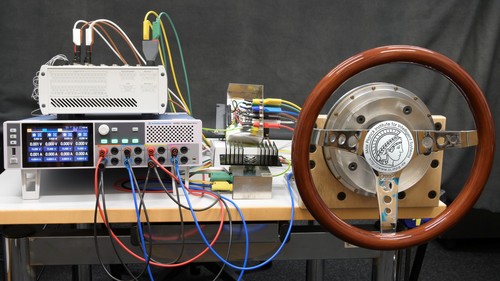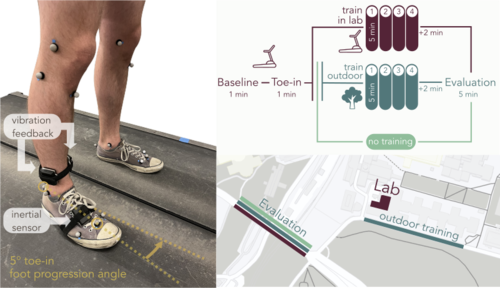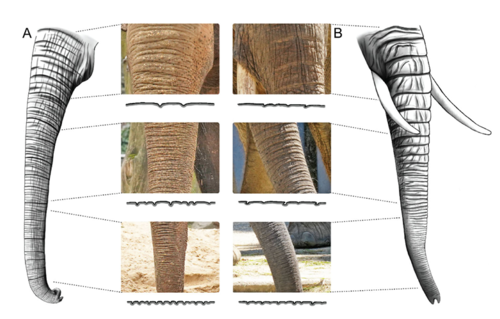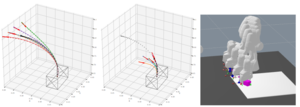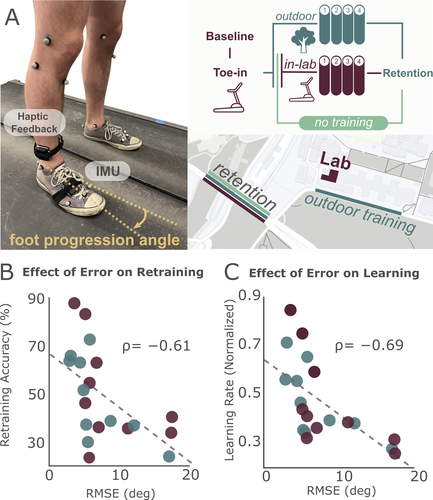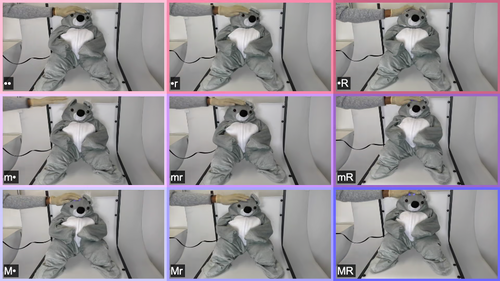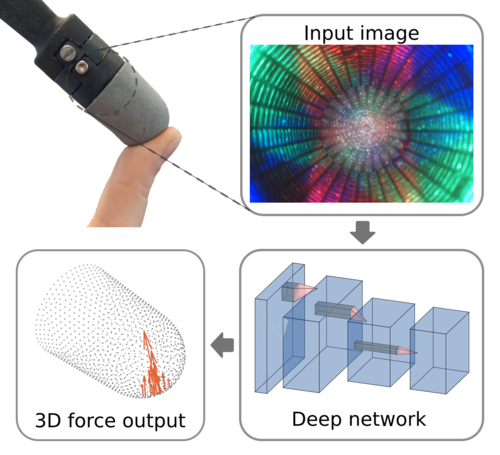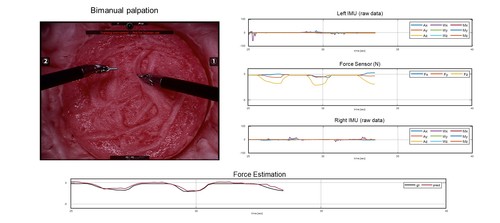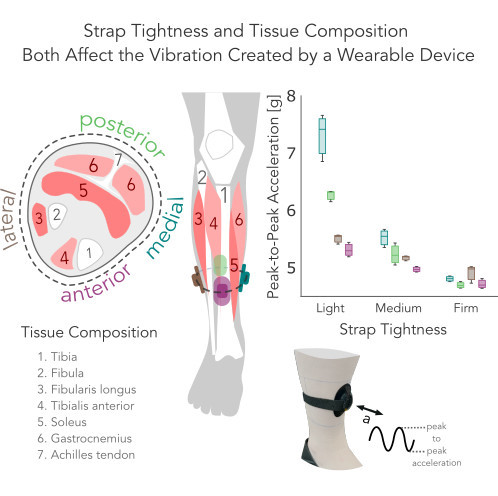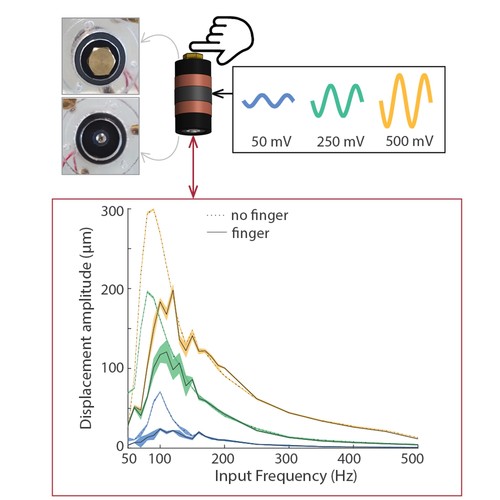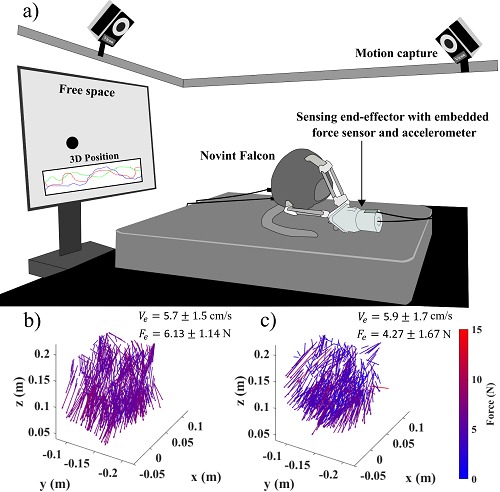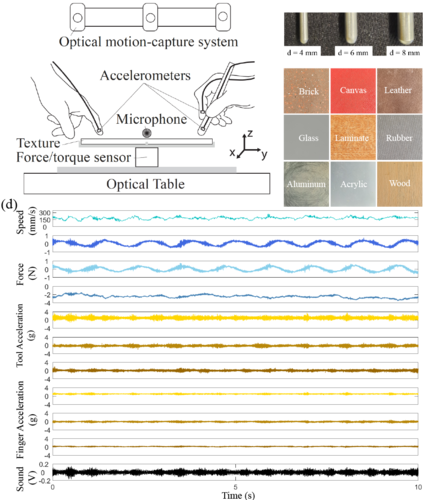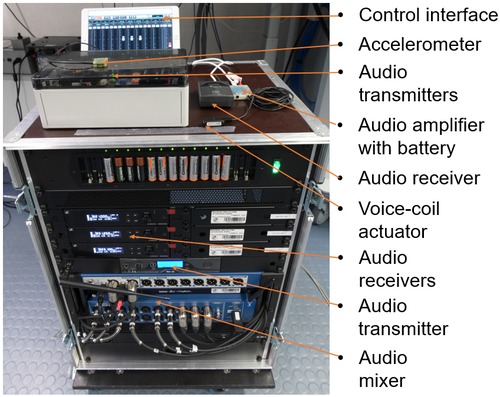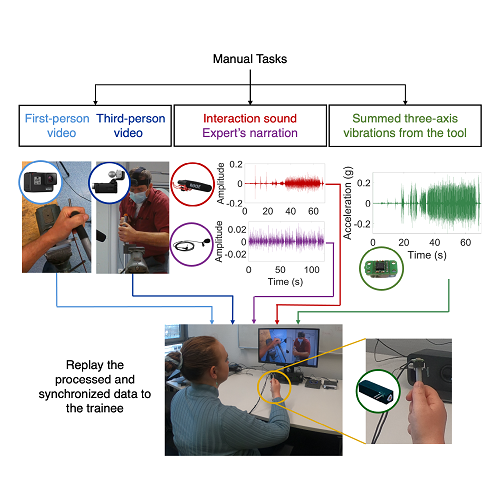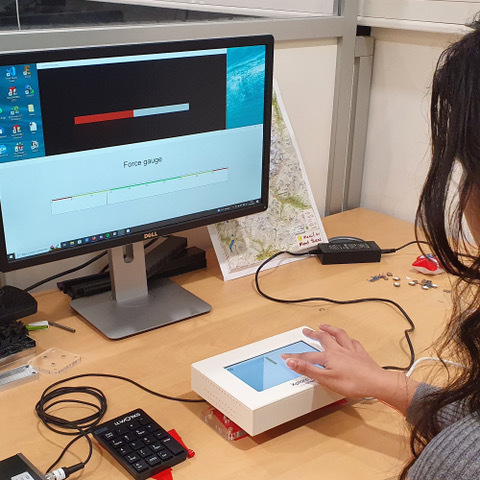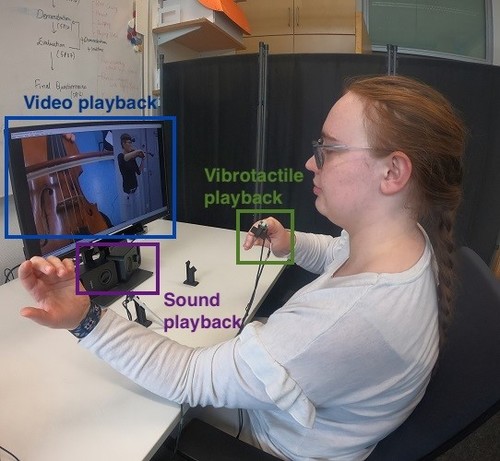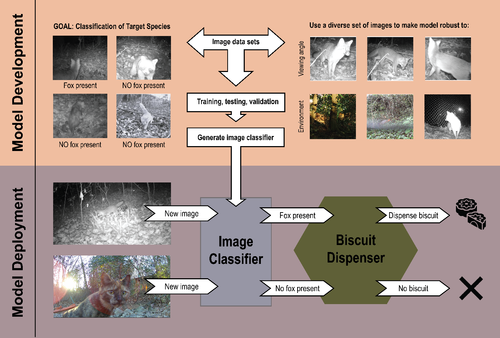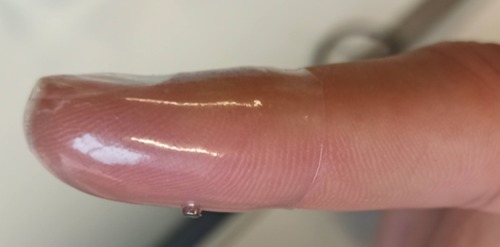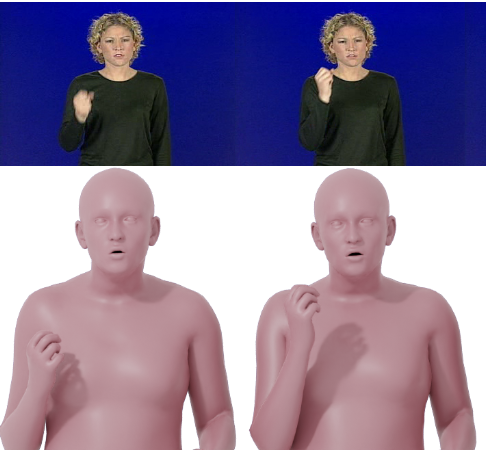2024
L’Orsa, R., Bisht, A., Yu, L., Murari, K., Westwick, D. T., Sutherland, G. R., Kuchenbecker, K. J.
Reflectance Outperforms Force and Position in Model-Free Needle Puncture Detection
In Proceedings of the Annual International Conference of the IEEE Engineering in Medicine and Biology Society (EMBC), Orlando, USA, July 2024 (inproceedings) Accepted
Rokhmanova, N., Martus, J., Faulkner, R., Fiene, J., Kuchenbecker, K. J.
GaitGuide: A Wearable Device for Vibrotactile Motion Guidance
Workshop paper (3 pages) presented at the ICRA Workshop on Advancing Wearable Devices and Applications Through Novel Design, Sensing, Actuation, and AI, Yokohama, Japan, May 2024 (misc) Accepted
Javot, B., Nguyen, V. H., Ballardini, G., Kuchenbecker, K. J.
CAPT Motor: A Strong Direct-Drive Rotary Haptic Interface
Hands-on demonstration presented at the IEEE Haptics Symposium, Long Beach, USA, April 2024 (misc)
Sanchez-Tamayo, N., Yoder, Z., Ballardini, G., Rothemund, P., Keplinger, C., Kuchenbecker, K. J.
Cutaneous Electrohydraulic (CUTE) Wearable Devices for Multimodal Haptic Feedback
Extended abstract (1 page) presented at the IEEE RoboSoft Workshop on Multimodal Soft Robots for Multifunctional Manipulation, Locomotion, and Human-Machine Interaction, San Diego, USA, April 2024 (misc)
Sanchez-Tamayo, N., Yoder, Z., Ballardini, G., Rothemund, P., Keplinger, C., Kuchenbecker, K. J.
Cutaneous Electrohydraulic Wearable Devices for Expressive and Salient Haptic Feedback
Hands-on demonstration presented at the IEEE Haptics Symposium, Long Beach, USA, April 2024 (misc)
Fazlollahi, F., Seifi, H., Ballardini, G., Taghizadeh, Z., Schulz, A., MacLean, K. E., Kuchenbecker, K. J.
Quantifying Haptic Quality: External Measurements Match Expert Assessments of Stiffness Rendering Across Devices
Work-in-progress paper (2 pages) presented at the IEEE Haptics Symposium, Long Beach, USA, April 2024 (misc)
Serhat, G., Kuchenbecker, K. J.
Fingertip Dynamic Response Simulated Across Excitation Points and Frequencies
Biomechanics and Modeling in Mechanobiology, April 2024 (article) Accepted
Sanchez-Tamayo, N., Yoder, Z., Ballardini, G., Rothemund, P., Keplinger, C., Kuchenbecker, K. J.
Demonstration: Cutaneous Electrohydraulic (CUTE) Wearable Devices for Expressive and Salient Haptic Feedback
Hands-on demonstration presented at the IEEE RoboSoft Conference, San Diego, USA, April 2024 (misc)
Mohan, M., Mat Husin, H., Kuchenbecker, K. J.
Expert Perception of Teleoperated Social Exercise Robots
In Proceedings of the ACM/IEEE International Conference on Human-Robot Interaction (HRI), pages: 769-773, Boulder, USA, March 2024, Late-Breaking Report (LBR) (5 pages) presented at the IEEE/ACM International Conference on Human-Robot Interaction (HRI) (inproceedings)
Schulz, A.
Being Neurodivergent in Academia: Autistic and abroad
eLife, 13, March 2024 (article)
Rokhmanova, N., Pearl, O., Kuchenbecker, K. J., Halilaj, E.
IMU-Based Kinematics Estimation Accuracy Affects Gait Retraining Using Vibrotactile Cues
IEEE Transactions on Neural Systems and Rehabilitation Engineering, 32, pages: 1005-1012, February 2024 (article)
Burns, R.
Creating a Haptic Empathetic Robot Animal That Feels Touch and Emotion
University of Tübingen, Tübingen, Germany, February 2024, Department of Computer Science (phdthesis)
Kaufmann, L., Schulz, A., Reveyaz, N., Ritter, C., Hildebrandt, T., Brecht, M.
Elephants develop wrinkles through both form and function
Society of Integrative and Comparative Biology, Seattle, USA, January 2024 (misc) Accepted
Schulz, A., Serhat, G., Kuchenbecker, K. J.
Adapting a High-Fidelity Simulation of Human Skin for Comparative Touch Sensing in the Elephant Trunk
Abstract presented at the Society for Integrative and Comparative Biology Annual Meeting (SICB), Seattle, USA, January 2024 (misc)
Singal, K., Schulz, A., Dimitriyev, M., Matsumoto, E.
Simplifying the Wrinkled Complexity of Elephant Trunks using Knitted Biomimicry
Society of Integrative and Comparative Biology, Seattle, USA, January 2024 (misc) Accepted
Shriver, C., Schulz, A., Scott, D., Elgart, J., Mendelson, J., Hu, D., Chang, Y.
Defining Mammalian Climbing Gaits and their influence criteria including morphology and mechanics
Society of Integrative and Comparative Biology, Seattle, USA, January 2024 (misc) Accepted
Sordilla, S., Schulz, A., Hu, D., Higgins, C.
Collagen entanglement in elephant skin gives way to strain-stiffening mechanisms
Society of Integrative and Comparative Biology, Seattle, USA, January 2024 (misc) Accepted
Khojasteh, B., Shao, Y., Kuchenbecker, K. J.
MPI-10: Haptic-Auditory Measurements from Tool-Surface Interactions
Dataset published as a companion to the journal article "Robust Surface Recognition with the Maximum Mean Discrepancy: Degrading Haptic-Auditory Signals through Bandwidth and Noise" in IEEE Transactions on Haptics, January 2024 (misc)
Fitter, N. T., Mohan, M., Preston, R. C., Johnson, M. J., Kuchenbecker, K. J.
How Should Robots Exercise with People? Robot-Mediated Exergames Win with Music, Social Analogues, and Gameplay Clarity
Frontiers in Robotics and AI, 10(1155837):1-18, January 2024 (article)
Khojasteh, B., Shao, Y., Kuchenbecker, K. J.
Robust Surface Recognition with the Maximum Mean Discrepancy: Degrading Haptic-Auditory Signals through Bandwidth and Noise
IEEE Transactions on Haptics, 17(1):58-65, January 2024, Presented at the IEEE Haptics Symposium (article)
Schulz, A., Kaufmann, L., Brecht, M., Richter, G., Kuchenbecker, K. J.
Whiskers That Don’t Whisk: Unique Structure From the Absence of Actuation in Elephant Whiskers
Abstract presented at the Society for Integrative and Comparative Biology Annual Meeting (SICB), Seattle, USA, January 2024 (misc)
Landin, N., Romano, J. M., McMahan, W., Kuchenbecker, K. J.
Discrete Fourier Transform Three-to-One (DFT321): Code
MATLAB code of discrete fourier transform three-to-one (DFT321), 2024 (misc)
2023
L’Orsa, R., Lama, S., Westwick, D., Sutherland, G., Kuchenbecker, K. J.
Towards Semi-Automated Pleural Cavity Access for Pneumothorax in Austere Environments
Acta Astronautica, 212, pages: 48-53, November 2023 (article)
Mohan, M.
Gesture-Based Nonverbal Interaction for Exercise Robots
University of Tübingen, Tübingen, Germany, October 2023, Department of Computer Science (phdthesis)
Khojasteh, B., Shao, Y., Kuchenbecker, K. J.
Seeking Causal, Invariant, Structures with Kernel Mean Embeddings in Haptic-Auditory Data from Tool-Surface Interaction
Workshop paper (4 pages) presented at the IROS Workshop on Causality for Robotics: Answering the Question of Why, Detroit, USA, October 2023 (misc)
Allemang–Trivalle, A.
Enhancing Surgical Team Collaboration and Situation Awareness through Multimodal Sensing
Proceedings of the ACM International Conference on Multimodal Interaction (ICMI), pages: 716-720, Extended abstract (5 pages) presented at the ACM International Conference on Multimodal Interaction (ICMI) Doctoral Consortium, Paris, France, October 2023 (misc)
Garrofé, G., Schoeffmann, C., Zangl, H., Kuchenbecker, K. J., Lee, H.
NearContact: Accurate Human Detection using Tomographic Proximity and Contact Sensing with Cross-Modal Attention
Extended abstract (4 pages) presented at the International Workshop on Human-Friendly Robotics (HFR), Munich, Germany, September 2023 (misc)
Khojasteh, B., Solowjow, F., Trimpe, S., Kuchenbecker, K. J.
Multimodal Multi-User Surface Recognition with the Kernel Two-Sample Test
IEEE Transactions on Automation Science and Engineering, pages: 1-16, August 2023 (article)
Oh, Y., Passy, J., Mainprice, J.
Augmenting Human Policies using Riemannian Metrics for Human-Robot Shared Control
In Proceedings of the IEEE International Symposium on Robot and Human Interactive Communication (RO-MAN), pages: 1612-1618, Busan, South Korea, August 2023 (inproceedings)
Rokhmanova, N., Pearl, O., Kuchenbecker, K. J., Halilaj, E.
The Role of Kinematics Estimation Accuracy in Learning with Wearable Haptics
Abstract presented at the American Society of Biomechanics (ASB), Knoxville, USA, August 2023 (misc)
Burns, R. B., Ojo, F., Kuchenbecker, K. J.
Wear Your Heart on Your Sleeve: Users Prefer Robots with Emotional Reactions to Touch and Ambient Moods
In Proceedings of the IEEE International Symposium on Robot and Human Interactive Communication (RO-MAN), pages: 1914-1921, Busan, South Korea, August 2023 (inproceedings)
Andrussow, I., Sun, H., Kuchenbecker, K. J., Martius, G.
Minsight: A Fingertip-Sized Vision-Based Tactile Sensor for Robotic Manipulation
Advanced Intelligent Systems, 5(8):2300042, August 2023, Inside back cover (article)
Lee, Y., Husin, H. M., Forte, M., Lee, S., Kuchenbecker, K. J.
Learning to Estimate Palpation Forces in Robotic Surgery From Visual-Inertial Data
IEEE Transactions on Medical Robotics and Bionics, 5(3):496-506, August 2023 (article)
Rokhmanova, N., Faulkner, R., Martus, J., Fiene, J., Kuchenbecker, K. J.
Strap Tightness and Tissue Composition Both Affect the Vibration Created by a Wearable Device
Work-in-progress paper (1 page) presented at the IEEE World Haptics Conference (WHC), Delft, The Netherlands, July 2023 (misc)
Ballardini, G., Kuchenbecker, K. J.
Toward a Device for Reliable Evaluation of Vibrotactile Perception
Work-in-progress paper (1 page) presented at the IEEE World Haptics Conference (WHC), Delft, The Netherlands, July 2023 (misc)
Khojasteh, B., Solowjow, F., Trimpe, S., Kuchenbecker, K. J.
Multimodal Multi-User Surface Recognition with the Kernel Two-Sample Test: Code
Code published as a companion to the journal article "Multimodal Multi-User Surface Recognition with the Kernel Two-Sample Test" in IEEE Transactions on Automation Science and Engineering, July 2023 (misc)
Fazlollahi, F., Taghizadeh, Z., Kuchenbecker, K. J.
Improving Haptic Rendering Quality by Measuring and Compensating for Undesired Forces
Work-in-progress paper (1 page) presented at the IEEE World Haptics Conference (WHC), Delft, The Netherlands, July 2023 (misc)
Khojasteh, B., Shao, Y., Kuchenbecker, K. J.
Capturing Rich Auditory-Haptic Contact Data for Surface Recognition
Work-in-progress paper (1 page) presented at the IEEE World Haptics Conference (WHC), Delft, The Netherlands, July 2023 (misc)
Gong, Y., Javot, B., Lauer, A. P. R., Sawodny, O., Kuchenbecker, K. J.
Naturalistic Vibrotactile Feedback Could Facilitate Telerobotic Assembly on Construction Sites
In Proceedings of the IEEE World Haptics Conference (WHC), pages: 169-175, Delft, The Netherlands, July 2023 (inproceedings)
Gong, Y., Javot, B., Lauer, A. P. R., Sawodny, O., Kuchenbecker, K. J.
AiroTouch: Naturalistic Vibrotactile Feedback for Telerobotic Construction
Hands-on demonstration presented at the IEEE World Haptics Conference, Delft, The Netherlands, July 2023 (misc)
Javot, B., Nguyen, V. H., Ballardini, G., Kuchenbecker, K. J.
CAPT Motor: A Strong Direct-Drive Haptic Interface
Hands-on demonstration presented at the IEEE World Haptics Conference, Delft, The Netherlands, July 2023 (misc)
Gourishetti, R., Javot, B., Kuchenbecker, K. J.
Can Recording Expert Demonstrations with Tool Vibrations Facilitate Teaching of Manual Skills?
Work-in-progress paper (1 page) presented at the IEEE World Haptics Conference (WHC), Delft, The Netherlands, July 2023 (misc)
Burns, R. B.
Creating a Haptic Empathetic Robot Animal for Children with Autism
Workshop paper (4 pages) presented at the RSS Pioneers Workshop, Daegu, South Korea, July 2023 (misc)
Gueorguiev, D., Rohou–Claquin, B., Kuchenbecker, K. J.
The Influence of Amplitude and Sharpness on the Perceived Intensity of Isoenergetic Ultrasonic Signals
Work-in-progress paper (1 page) presented at the IEEE World Haptics Conference (WHC), Delft, The Netherlands, July 2023 (misc)
Gourishetti, R., Hughes, A. G., Javot, B., Kuchenbecker, K. J.
Vibrotactile Playback for Teaching Manual Skills from Expert Recordings
Hands-on demonstration presented at the IEEE World Haptics Conference, Delft, The Netherlands, July 2023 (misc)
Schulz, A., Anderson, C. D., Cooper, C., Roberts, D., Loyo, J., Lewis, K., Kumar, S., Rolf, J., Marulanda, N. A. G.
A Toolkit for Expanding Sustainability Engineering Utilizing Foundations of the Engineering for One Planet Initiative
In Proceedings of the American Society of Engineering Education (ASEE), Baltimore, USA, June 2023, Andrew Schulz, Cindy Cooper, Cindy Anderson contributed equally. (inproceedings)
Schulz, A., Stathatos, S., Shriver, C., Moore, R.
Utilizing Online and Open-Source Machine Learning Toolkits to Leverage the Future of Sustainable Engineering
In Proceedings of the American Society of Engineering Education (ASEE), Baltimore, USA, June 2023, Andrew Schulz and Suzanne Stathatos are co-first authors. (inproceedings)
Gertler, I., Serhat, G., Kuchenbecker, K. J.
Generating Clear Vibrotactile Cues with a Magnet Embedded in a Soft Finger Sheath
Soft Robotics, 10(3):624-635, June 2023 (article)
Block, A. E., Seifi, H., Hilliges, O., Gassert, R., Kuchenbecker, K. J.
In the Arms of a Robot: Designing Autonomous Hugging Robots with Intra-Hug Gestures
ACM Transactions on Human-Robot Interaction, 12(2):1-49, June 2023, Special Issue on Designing the Robot Body: Critical Perspectives on Affective Embodied Interaction (article)
Forte, M., Kulits, P., Huang, C. P., Choutas, V., Tzionas, D., Kuchenbecker, K. J., Black, M. J.
Reconstructing Signing Avatars from Video Using Linguistic Priors
In IEEE/CVF Conf. on Computer Vision and Pattern Recognition (CVPR), pages: 12791-12801, CVPR 2023, June 2023 (inproceedings)


